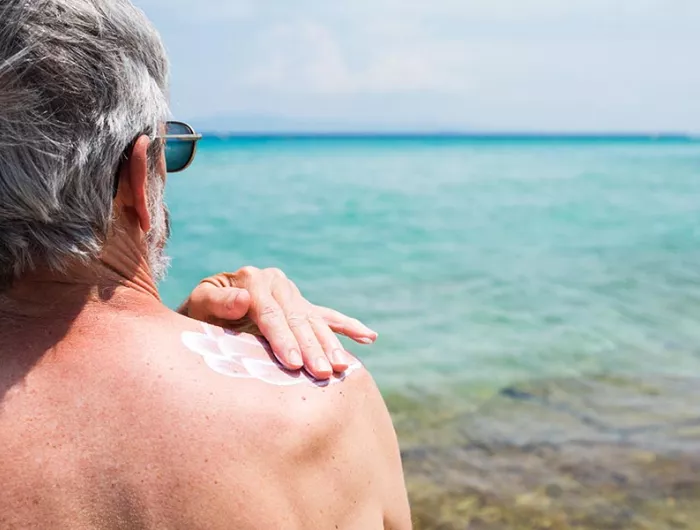How to trim your risk of skin cancer (and wrinkles)

Creative Family - stock.adobe.com.
The best way to lower your risk of skin cancer: Avoid damage from the sun’s ultraviolet (UV) rays. (Bonus: That can also help keep your skin looking young.) Here’s what to do.
What causes wrinkles
“The skin on the backside of an 80-year-old doesn’t look that different than the skin on the backside of a 20-year-old,” says Gary Fisher, a professor in the department of dermatology at the University of Michigan Medical School.
That’s because the main cause of wrinkled skin isn’t your age. It’s exposure to the sun. “Ultraviolet radiation from the sun causes a wound-healing response in the skin, even though there’s no open wound,” notes Fisher.
“Part of the response is inflammation, which leads to collagen breakdown. Over time, the damage from those repeated UV insults accumulates to the point that the skin’s appearance changes.”

And those changes are not just cosmetic.
“With photoaging, you get deep wrinkles and irregular pigmentation, plus lesions that may lead to skin cancer,” explains Erica Stevens, a dermatologist also at the University of Michigan Medical School.
“Photoaging is not nearly as prevalent in people with dark complexions,” she says. That’s because they have more melanin—a dark brown or black pigment in the skin, hair, and eyes—than people with lighter skin color.
Sun exposure creates more melanin—that’s what makes you tan. But don’t expect a tan to protect your skin if you’re fair-skinned.
“A tan is a sign of damage,” says Stevens. “It’s essentially your skin’s response to the UV damage by trying to protect itself.”
You can also thank your genes and years of squinting, smiling, and frowning for wrinkles. Smoking is to blame, too.
That said, here’s what you can do to help keep your skin looking young.
How to avoid sun damage
The best way to prevent UV damage is to avoid the sun by seeking shade or wearing a wide-brimmed hat and protective clothing.
Tightly woven fabrics like denim, wool, and polyester provide more UV protection than looser-woven fabrics like linen and most cotton.
“You can also look for clothing with a UPF”—ultraviolet protection factor—“label, which tells you how much UV light is filtered out,” says Stevens. For example, an item that’s rated UPF 50 lets through just 1/50th of the sun’s UV light.
And UV-blocking sunglasses can protect your eyelids from skin cancer (and lower your risk of cataracts). Look for sunglasses labeled UV400 or for ones that block at least 99 percent of UV rays.
When shade or clothing won’t cut it, sunscreen is the next best thing.
Sunscreen tips
Look for SPF 30 or higher
“You want to aim for an SPF—or sun protection factor—of at least 30,” says Stevens. SPF 15 blocks 93 percent of UVB rays (which cause sunburns, skin cancer, and photodamage). SPF 30 blocks 97 percent.
“You can get small increases in protection as you go from SPF 30 to 50 to 70, but the effect is slight.”
Use a broad spectrum sunscreen
“We used to think that only UVB rays caused damage, but now we know that UVA also plays a role,” notes Stevens. UVA penetrates deeper into the skin and is a chief culprit in photoaging.
Your best bet: a “broad spectrum” sunscreen, which protects against UVA and UVB rays. (Unfortunately, there’s no SPF rating system for UVA, so you don’t know how much protection you’re getting.)
Apply often
“If you’re in the sun, you should reapply sunscreen every two hours,” says Stevens. And most of us don’t use nearly enough. “If most of your body is exposed to the sun, use about an ounce, or a shot glass worth, of sunscreen.” If you use less, you’ll get less protection. “Based on typical usage, someone using an SPF 70 may only get the equivalent of SPF 40.”
If you’ll be sweating or in water, opt for water resistant sunscreens, which last for 40 to 80 minutes.
Stevens also recommends sunscreen for people with dark skin. “You do have some natural protection thanks to melanin, but folks with darker skin can and do get skin cancer.”
Do it year round
UVB is more intense in the summer, at higher elevations, and in locations closer to the equator.
But UVA rays account for roughly 95 percent of UV radiation. And UVA intensity doesn’t vary much by season, weather, or location. Nor is UVA blocked by glass.
“If your skin is exposed to daylight, I always advocate for wearing sunscreen, even on cloudy days and in the winter,” says Stevens.
Concerned that you won’t make enough vitamin D if you cover up and use sunscreen? You can always take a vitamin D supplement.
Photo: creativefamily/stock.adobe.com. Illustration: designua/stock.adobe.com.

